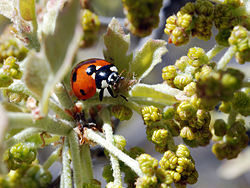
- Kingdom: Animalia
- Phylum: Arthropoda
- Class: Insecta
- Order: Coleoptera
- Family: Coccinellidae
- Chilocorinae
- Coccidulinae
- Coccinellinae
- Epilachninae
- Scymininae
- Sticholotidinae

| Ladybug |
|---|
 |
| Scientific Classification |
|
| Subfamilies |
|
| Ladybug larvae |
 |
The ladybug, also known as the ladybird or lady beetle, is a very extraordinary insect. The family Coccinellidae is the main family of all ladybugs. Throughout the world there are over 5,000 different species, there are 450 native to North America alone. The ladybug is a small oval shaped insect with a hard outer shell. They are commonly the color of red, yellow or orange and have a variety of black spots. However there are a lot of them that are black, gray or brown with a variety of white spots. In some cases they have faded or no spots. The reasoning of them having faded spots is because the older the ladybug gets the lighter their spots appear.
They feed upon aphids, mealybugs, and mites. Because of their eating habits they are very much welcome in gardens because they eat all of the pests that kill the other growing things. Some people even intentionally put them in their gardens to keep them pest free instead of using harsh chemicals that could damage the wanted plants. So they have become known as, in a way, a natural pest control. People have even become to believe that seeing them in their gardens is a sign of good luck and don't even begin to think about killing them because that would reverse their good luck to bad.[1]
Ladybugs are a type of insect known as beetles. They have tiny oval bodies that are usually a little less then 1/4 in. long. They all have elytra, wing covers, that are a variety of colors. The most common colors are red, orange and yellow with black spots, but there are also black with red spots and in some cases they have no spots on them at all. These spots are used for people to be able to identify the specific type of ladybug it is. Underneath the elytra wings the ladybug has smaller more fragile wings that are so small that you can see through them. The elytra is used as a hard shell of protection to keep those fragile wings from being damaged. Just behind the head you find the pronotum, which is usually easy to find because it has little white spots on it. The particular part of the ladybugs body helps protect and hide the head. They have six jointed legs, just as all other insects do,and on their feet are special organs that help them smell. They also have antennae that they use to touch, smell and taste. All that being the overall anatomy of the average ladybug.[2]
Ladybugs reproduce sexually, the male attaches to the back of the female as they mate. Once the males sperm is inside of the female she can store it for up to three months before laying her eggs.[3] They lay their eggs in colonies of aphids, usually containing about 200 eggs, on the bottom parts of leaves.[4] The eggs hatch in a two to five day time period. After they hatch they feed on aphids for about two to three weeks until they are ready to enter into the pupa stage. In about a week an adult ladybug emerges from the pupa and starts its life. On average the life cycle of the ladybug last between four to six weeks long.[5]
Ladybugs live in a wide variety of habitats including forests, grasslands, fields, gardens, and in some cases peoples houses. Out of all these places they are particularly welcome in gardens. People have even began intentionally putting them in their gardens as a natural pest control instead of using harmful chemicals. This is because their main diet consists of aphids, mealy bugs, and mites, all of these being garden pests. Both adult ladybugs and their larvae share the same diet just in different portions. The larvae usually eat about 25 aphids a day as the adults can eat up to 50. Like most other insects ladybugs that live in more temperate regions enter diapause during the winter season.Just as they are the predators of aphids, mealy bugs and mites they too have predators. The main predator they seem to have is birds. When they sense attack they either act dead or they send out a strong chemical that takes bad to the predator, making them not want go any further with disturbing them. [6]
The lady bug is an extraordinary insect some fun facts about them are:
 Browse |
|
||||||||||||||||||||